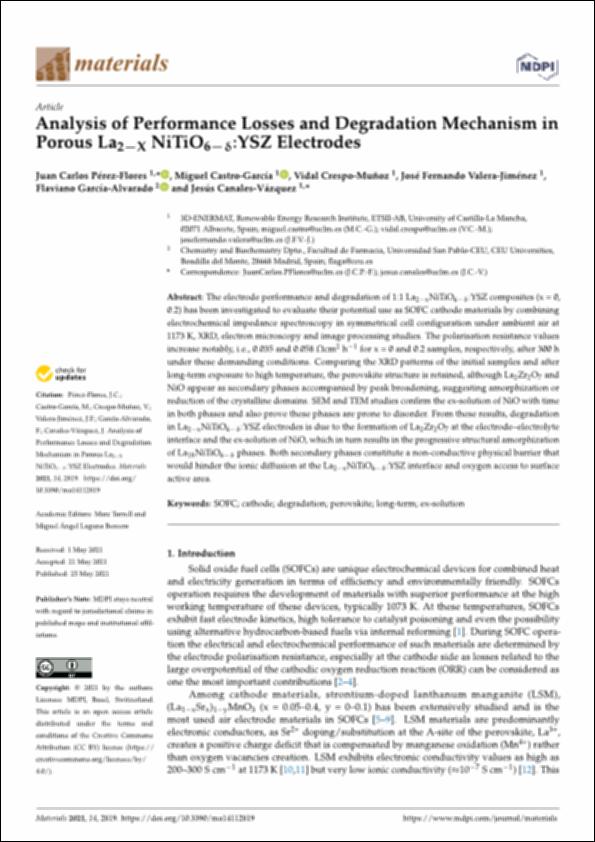Please use this identifier to cite or link to this item:
http://hdl.handle.net/10637/14740Analysis of Performance Losses and Degradation Mechanism in Porous La2-X NiTiO66-Ç:YSZ Electrodes
| Title: | Analysis of Performance Losses and Degradation Mechanism in Porous La2-X NiTiO66-Ç:YSZ Electrodes |
| Authors : | Pérez Flores, Juan Carlos Castro García, Miguel Crespo Muñoz, Vidal Valera Jiménez, José Fernando García Alvarado, Flaviano Canales Vázquez, Jesús |
| Keywords: | SOFC; Cathode; Degradation; Perovskite; Long-term; Ex-solution |
| Publisher: | MDPI |
| Citation: | Pérez-Flores, J.C.; Castro-García, M.; Crespo-Muñoz, V.; Valera-Jiménez, J.F.; García-Alvarado, F.; Canales-Vázquez, J. Analysis of Performance Losses and Degradation Mechanism in Porous La2X NiTiO6 :YSZ Electrodes. Materials 2021, 14, 2819. https://doi.org/ 10.3390/ma14112819 |
| Abstract: | The electrode performance and degradation of 1:1 La2-xNiTiO6-ç:YSZ composites (x = 0, 0.2) has been investigated to evaluate their potential use as SOFC cathode materials by combining electrochemical impedance spectroscopy in symmetrical cell configuration under ambient air at 1173 K, XRD, electron microscopy and image processing studies. The polarisation resistance values increase notably, i.e., 0.035 and 0.058 Wcm2 h-1 for x = 0 and 0.2 samples, respectively, after 300 h under these demanding conditions. Comparing the XRD patterns of the initial samples and after long-term exposure to high temperature, the perovskite structure is retained, although La2Zr2O7 and NiO appear as secondary phases accompanied by peak broadening, suggesting amorphization or reduction of the crystalline domains. SEM and TEM studies confirm the ex-solution of NiO with time in both phases and also prove these phases are prone to disorder. From these results, degradation in La2-xNiTiO6-ç:YSZ electrodes is due to the formation of La2Zr2O7 at the electrode–electrolyte interface and the ex-solution of NiO, which in turn results in the progressive structural amorphization of La18NiTiO6-ç phases. Both secondary phases constitute a non-conductive physical barrier that would hinder the ionic diffusion at the La2-xNiTiO6-ç:YSZ interface and oxygen access to surface active area. |
| URI: | http://hdl.handle.net/10637/14740 |
| Rights : | http://creativecommons.org/licenses/by-nc-nd/4.0/deed.es OpenAccess |
| ISSN: | 1996-1944 |
| Issue Date: | 25-May-2021 |
| Center : | Universidad San Pablo-CEU |
| Appears in Collections: | Facultad de Farmacia |
Items in DSpace are protected by copyright, with all rights reserved, unless otherwise indicated.


